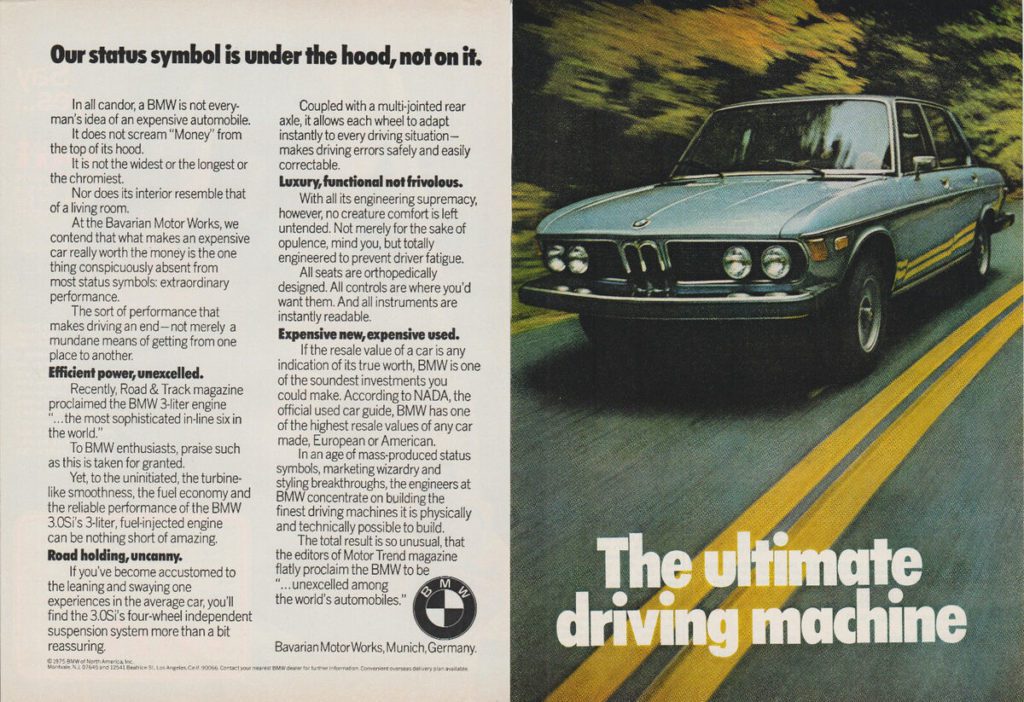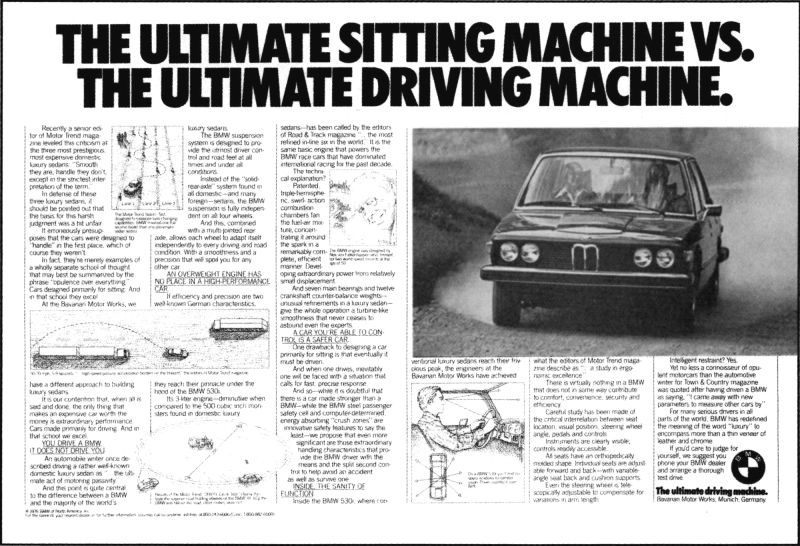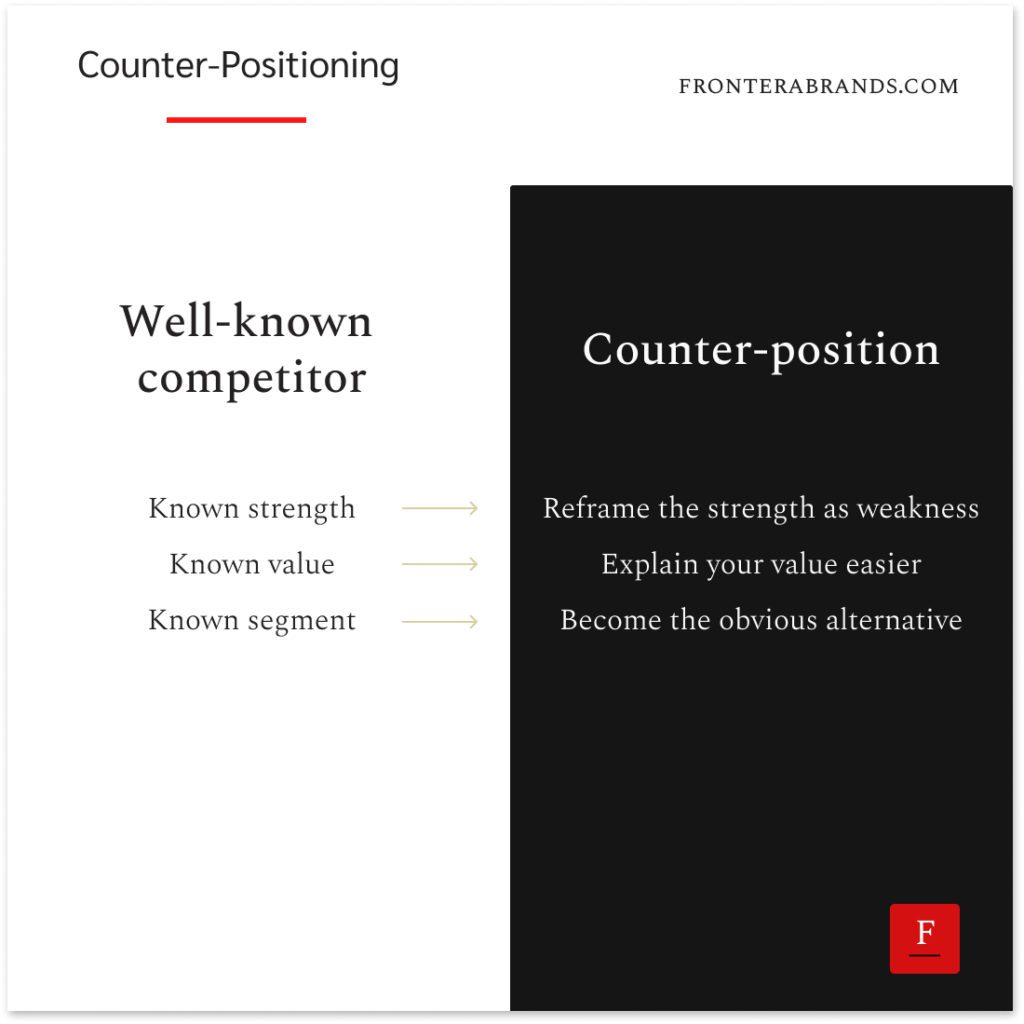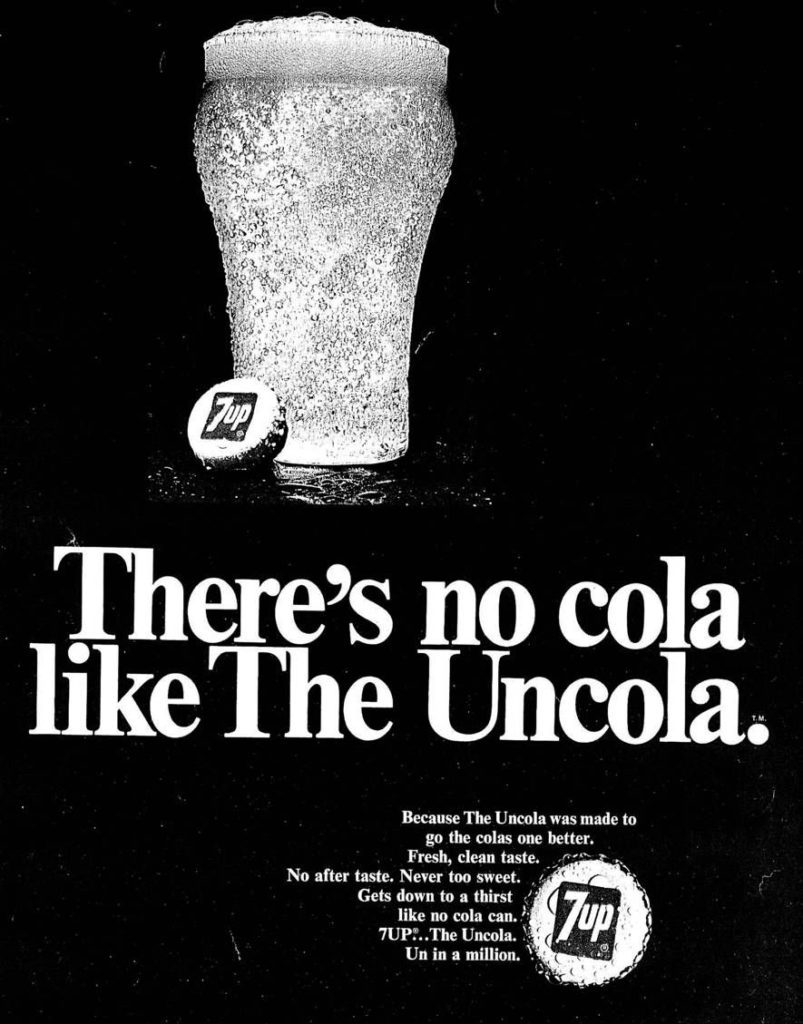In the 1970s, BMW was an unpopular brand in the US.
The other German brands already captured a place in American drivers’ minds.
Mercedes meant comfort.
Porsche meant sporty luxury.
And Volkswagen meant practicality.
But BMW?
It had no identity.
Some people didn’t even know that it was German — they thought BMW stood for British Motor Works.
So they didn’t buy it.
BMW’s new CEO Eberhard von Kuenheim was aware of the problem.
He knew they had to find and communicate what makes BMW different to succeed in the most important car market in the world.
So his team started knocking on the doors of advertising agencies.
After talking with many, they decided to work with Ammirati & Puris (A&P).
It was a relatively new agency.
But they did a good job with a Fiat campaign.
So BMW management decided to give them a shot.
A&P’s copywriters spent weeks talking to BMW’s different teams from marketing to production to find an angle about the brand.
One thing became clear.
BMW was managed by engineers from the bottom to the top.
All the executives were engineers and they truly cared about the details.
How the engine sounded, how the cars took turns, how the suspension handled bumps…
The people behind BMW were true car nerds.
And it showed in their cars.
But up to that point, they couldn’t find a way to explain it to the American public.
After spending time with BMW employees, A&P’s copywriters wrote the slogan for the new campaign:
“The Ultimate Driving Machine.”

But A&P didn’t stop with the beautiful slogan.
They knew they had to show their German origins, and also stand out among other German brands.
So they decided to choose an enemy: Mercedes.
Mercedes was known for its comfort.
A&P copywriters knew nobody could change people’s minds about Mercedes cars’ comfort.
So that’s why they decided to reframe that strength as a weakness.
If BMW was the ultimate driving machine, what could the comfortable Mercedes be?
The ultimate sitting machine.

The result?
People loved the campaign.
Everybody started noticing BMWs and how driving a BMW feels different.
There was no doubt Mercedes cars were comfortable — even BMW accepted that.
But focusing on the joy of driving as a single point of differentiation gave BMW a unique place in US drivers’ minds.
BMW gained an identity.
So sales in the US increased from 13,000 cars a year to 90,000 in ten years.
That’s how the rivalry between BMW and Mercedes started.
It’s still going on with genius ads — like when BMW showed Mercedes’ retiring CEO driving a BMW.
When your enemy defines you
Now, here’s the thing.
A&P helped BMW discover what makes the brand truly different.
But to communicate that difference to customers, they used something beyond a good tagline.
They chose an enemy.
And they didn’t try to defuse Mercedes’ strength.
They accepted it.
They even mentioned it in their campaign.
It was a bold move.
But it had several benefits for BMW.
First, by openly accepting something many customers know (Mercedes = comfort) they increased their own claim’s believability.
Remember value tradeoffs.
Every strength comes with a weakness.
And BMW found a way to show it to people.
Second, it positioned itself as the main challenger against a strong brand.
Mercedes was already strong in the US market.
Customers knew what it stood for.
So by choosing Mercedes as the enemy, BMW implied they are in the same league.
We talked about anchoring in the last edition.
BMW anchored itself to Mercedes — while telling how it’s different.
It used Mercedes’ image to get into their minds.
And it became easy for customers to understand why they should choose BMW (or not).
Do you care about the joy of driving?
Buy a BMW.
Do you care about comfort?
We are not for you. Go buy Mercedes.
And that’s counter-positioning.
You choose an enemy that helps customers understand your difference and position yourself as the obvious alternative.

Now, one note here.
In his book 7 Powers, Hamilton Helmer talks about counter-positioning based on business models (e.g. Netflix’s subscription vs Blockbuster’s rental model).
It’s an interesting topic to cover in a future edition.
But here we are strictly talking about brand positioning.
So, how can you use counter positioning even if you don’t have a beautiful car brand like BMW?
Here are the steps:
Five steps to counter-position your brand successfully:
1. Find the big idea
Every brand needs its big idea.
We can call it a point of differentiation.
Or a reason to exist.
Why should customers choose you over others?
What makes you meaningfully different?
It’s not easy to answer these questions.
But only finding good answers can build a winning brand.
Some businesses already have that big idea without knowing it.
Like BMW.
BMW employees were so into what they did, they were blind to what made them different.
What was normal for BMW engineers (attention to driving experience) was not so normal for other car brands.
But they needed an outsider to see that and explain it to the customers.
So the first step of counter-positioning is finding the big idea behind your brand.
Only then can you find the right enemy to position against.
2. Choose a worthy enemy
You’ve probably heard of this saying in some superhero movies:
“Your enemies define you.”
This works for branding too.
Because when you have a villain to fight, it’s easier for people to understand your difference.
It draws clear lines:
“This is our enemy, and we stand against what they stand for.”
That’s why it’s important to choose a well-known enemy.
Because people will intuitively put you in the same league as the competitor you choose.
We talked about Avis’s counter positioning against market leader Hertz and T-Mobile’s Un-carrier move.

But the enemy doesn’t even need to be a single competitor.
It can be customers’ existing way of doing things (e.g. Slack vs email).
Or a problem in your industry (e.g. Patagonia vs fast fashion).
So choose a mighty enemy.
And you’ll become the obvious alternative.
3. Exploit the weakness in the strength
This step is important.
Never try to refute the competitor’s known strength.
It rarely works.
Plus it reduces the believability of other things you claim.
On the contrary, you have to accept general opinion.
Like BMW did with Mercedes.
But you have to find the weakness inside their strength.
A weakness that fits well with your capability.
How?
Let’s continue with the Mercedes example.
Their strength —comfort— can mean multiple weaknesses:
- More expensive
- Less reliable
- Less safe
- Less fun to drive
In this case, the weakness that fit into BMW’s strength was “less fun to drive.”
And they positioned Mercedes as the ultimate sitting machine.
So don’t try to change people’s minds about your competitor’s strength.
But reframe it as a weakness.
4. Ignore customers who don’t believe in what you believe
Counter-positioning has a counterintuitive aspect.
You have to deliberately ignore a set of customers.
You have to tell them “We are not for you.”
Why?
Because if you claim to be different than a competitor, what you offer shouldn’t be built for their audience.
It’s by definition.
You have to ignore their needs while building your product.
And maybe even antagonize them in your campaigns.
Because you are serving people who believe in what you believe.
BMW drivers believe driving should be fun.
Volvo drivers believe safety comes first.
Porsche drivers believe your car should make others jealous.
Strong brands have their ideologies.
And they have believers.
Customers choose sides while buying products they care about.
A BMW or Apple fan might defend the brand against critics like somebody cursed his mother.
That’s why it’s so important to stay loyal to your believers.
And ignore others.
The moment you try to be for everybody, you take away your customers’ reason to follow you.
Remember brand dilution.
5. Walk the talk
And the last step.
BMW’s “The Ultimate Driving Machine” slogan worked — because the company truly made fun cars.
The experience matched the claim (remember the priming effect).
So once you find your point of differentiation, you have to align everything you do around it.
Design, product, customer service — every customer touchpoint should convey your positioning.
I’ve seen businesses that had a good positioning idea.
But they failed to become it.
Their website implied one thing.
Their sales talked about another thing.
And the actual product/service represented something else.
Imagine if Ritz-Carlton had an average customer service after saying “Ladies and gentlemen serving ladies and gentlemen.”
Would their positioning work?
Of course not.
So claiming a counter position is half of the job.
The other half is being it.
–
Enjoyed this article?
Then you’ll love the How Brands Win Newsletter.
Get the “5 Mental Models to Differentiate Your Business” guide when you join. It’s free.
